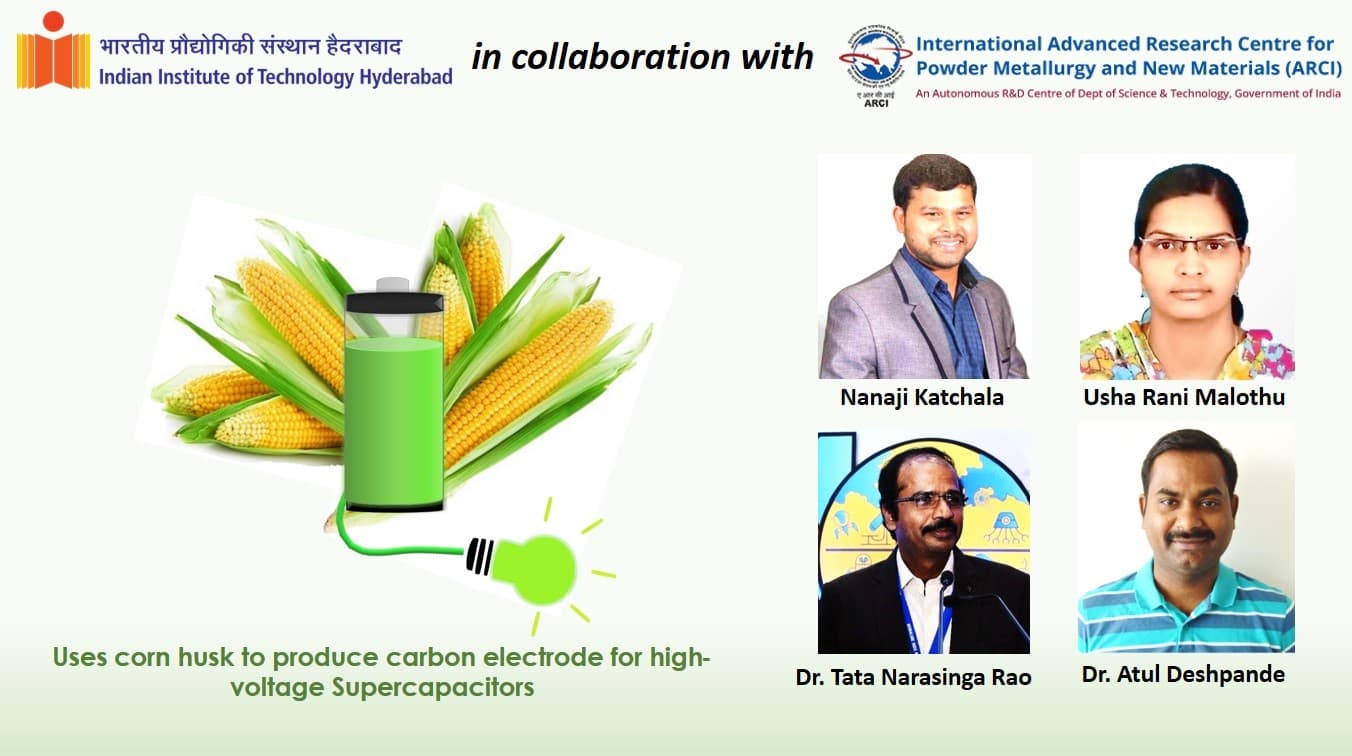Researchers at IIT Hyderabad 2020: Great use of cornhusk for producing CE

Researchers at IIT Hyderabad have developed a simple and cost effective method to derive ‘activated carbon electrode’ material from cornhusk for high-voltage supercapacitors.
The electrode of Researchers at IIT Hyderabad showed better electrochemical performance (High energy density and high-power density) when compared with conventional supercapacitors.


This development achieved by Researchers at IIT Hyderabad is important for states such as Uttar Pradesh and the combined Andhra Pradesh-Telangana States, which are the first and second largest producers of corn in the country respectively.
They produce a large amount of cornhusk waste, much of which waste is currently burnt as its potential to be converted to valuable electrode material is not harnessed owing to lack of awareness, expertise and technology.
This work by Researchers at IIT Hyderabad on affordable and efficient methods can enable this conversion, which would trigger the cascade of additional earning opportunity for the corn-farmer and provision of a sustainable energy source.

Researchers at IIT Hyderabad were led by Dr. Atul Suresh Deshpande, Associate Professor, Department of Materials Science and Metallurgical Engineering, IIT Hyderabad in collaboration with Dr. T. N. Rao, Associate Director, International Advanced Research Centre for Powder Metallurgy and New Materials (ARCI), Hyderabad along with their Research students, M. Usha Rani and K. Nanaji (Project Scientist).
The paper of Researchers at IIT Hyderabad detailing the synthesis procedure and the electrochemical performance of the material produced has been recently published in the reputed peer-reviewed Journal of Power Sources.
In the global sector, rapid advancements in adopting new technology and fast evolving green energy systems are trending in the supercapacitor’s market.

It is projected to share USD 720 million by 2025 market value, which is expected to grow at a CAGR of 12 per cent from 2020 to 2025.
Carbon based electrodes are playing a crucial role in the development of energy storage devices.
They are typically derived from expensive, high purity precursors such as polymers, organic precursors, high purity gases using various methods.

The production of carbon electrodes from biomass is a simpler straightforward process.
In collaboration with ARCI (Hyderabad), the IIT Hyderabad team has developed activated carbon electrode using simple materials – Corn husk and KOH.
In collaboration with ARCI (Hyderabad), Researchers at IIT Hyderabad have developed activated carbon electrode using simple materials – Corn husk and KOH.
Dr. Atul Deshpande speaking about the work of Researchers at IIT Hyderabad said activated carbon electrode material with porous sheet-like morphology has been prepared using corn husk through carbonization followed by KOH activation.
Due to the low-cost precursors and simple processing method, this process of producing activated carbon can be easily adapted for large-scale commercial production, he said.
To obtain the high surface area activated carbon with porous sheet-like morphology from corn husk, the Researchers at IIT Hyderabad added KOH as an activating agent.
KOH helps in the formation of sheet-like morphology. The synergy of morphology and high specific surface area (1378 m2 g-1) improve the storage capacity of the activated carbon electrode material.

This electrode showed better electrochemical performance (High energy density (20 Wh kg-1) and high-power density (681 W kg-1) at 1 A g-1) than electrodes in conventional supercapacitors.

The key scientific challenge in this research is pore size engineering of activated carbon with high surface area and suitable pore size that allows the electrolyte ions to adsorb into pores to maximum extent which in turn give high capacity.
‘The Researchers at IIT Hyderabad in collaboration with ARCI has succeeded in converting corn husk into high performing activated carbon for supercapacitor application.’
Corn husk being widely produced waste, it is also scalable from technology point as well, said Dr. T.N. Rao.
S Vishnu Sharmaa now works with collegechalo.com in the news team. His work involves writing articles related to the education sector in India with a keen focus on higher education issues. Journalism has always been a passion for him. He has more than 10 years of enriching experience with various media organizations like Eenadu, Webdunia, News Today, Infodea. He also has a strong interest in writing about defence and railway related issues.






